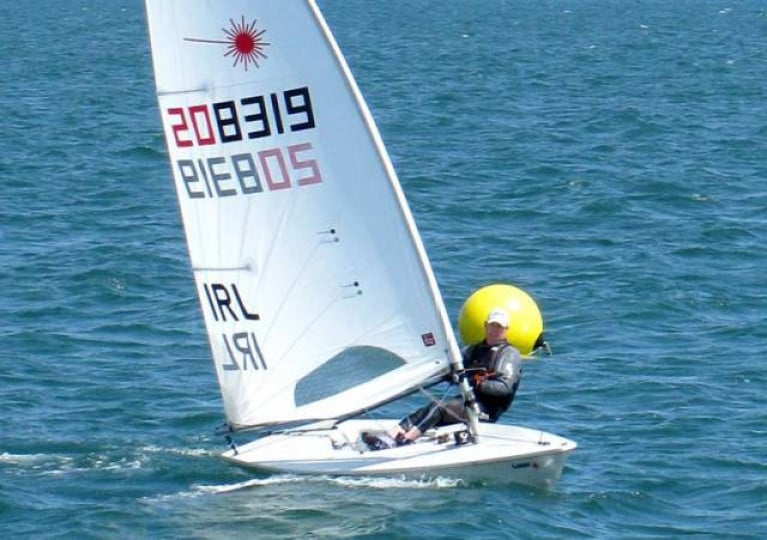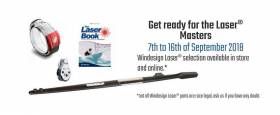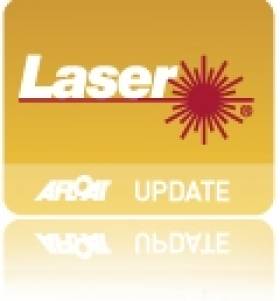Displaying items by tag: Laser Masters
Royal St George Welcomes Laser Masters This Weekend
Update Friday 18 September: The Irish Laser Masters have been cancelled on the eve of the event after Dublin was moved into Level 3 of coronavirus restrictions. Afloat.ie has more on the story HERE.
The Royal St George Yacht Club welcomes the Laser class to Dun Laoghaire for their Masters Nationals this coming Saturday 19 and Sunday 20 September.
As previously reported on Afloat.ie, the event was one of he first to reschedule in the wake of coronavirus restrictions earlier this year.
And the current climate means that there will be no formal shoreside activities to accompany the weekend of racing.
The club will be making use of its Virtual Race Office, while competitors can connect via an event WhatsApp group, and any protest hearings will be held using the Zoom platform.
There will also be a virtual draw during the regatta for both Standard and Radial sailors, with two £100 vouchers for main sponsor Lennon Racewear up for grabs.
Visiting boats (any not currently on the RStGYC deck) are asked to contact the sailing office — 01 280 1811 ext 3 or [email protected] — in advance of planned arrival to ensure access to club facilities.
In other news, the Notice of Race and Sailing Instructions are now available for the Laser Munsters taking place on the weekend of 3-4 October at Kinsale Yacht Club.
Registration is open now, and the list of entrants already confirmed is also online.
New Date Set For Irish Laser Masters This Autumn
Dun Laoghaire’s dinghy fleet reports that the Irish Laser Masters will now take place on the weekend of 19-20 September at the Royal St George Yacht Club.
The Laser Masters was one of a number of events that fell to the current restrictions against Covid-19 as the Irish Laser Class Association postponed all events in the class until August at the earliest.
These include the Laser Radial Europeans, which had been scheduled to be hosted by Ballyholme Yacht Club from 4-11 July but are now moving to a different, ‘warmer’ venue if a date can be found in October or November.
Plans are still in the offing for the Laser Nationals at the Royal Cork from 20 August to go ahead as scheduled, pending Government advice.
Get Ready For The Laser Masters With Viking Marine
#VikingMarine - Getting ready for the Laser Masters on Dublin Bay next week from Friday 7-Saturday 15 September?
Stay local with Dun Laoghaire’s leading chandlery Viking Marine, who can help with their selection of Windesign Laser products and wide range of top brands in whatever you might need for a day’s racing — from ropes to boat fittings to clothing and much more.
Order online at VikingMarine.ie or shop in store at The Pavilion close to the waterfront.
#laser – Royal Cork's Nick Walsh was the winner of the 31–boat Laser Master Championships sailed on Dublin Bay at the weekend. With four race wins to his credit, the Cork Harbour sailor was seven points clear of runner up Dan O'Connell after six races sailed.
Every championship regatta is a network of many moving parts that organisers pray will mesh neatly on the day. The biggest moving part in our sport of sailing is of course the weather and over this we have no control. In the RIYC on Friday morning after five months of planning the 2014 LogMein Laser Masters Championship began to grind into action. As boats were being branded with sponsor decals a perfect breeze under a clear sky kicked in. Suddenly it appeared as if the whole thing just might work.
Saturday morning dawned the same as Friday, overcast skies and a pleasantly warm air temperature. By 11am the weather pattern was repeating itself as clouds burnt off, a blue sky revealed itself and thank you thank you thank you the first zephyrs of breeze began to appear in the flags on the mast above the RIYC forecourt.
Boats arrived all morning from the major Laser sailing centres of Cork and Ballyholme though the turnout from closer fleets like Howth was very disappointing for the organisers. Local sailors didn't need to bring their boats to the RIYC and launched from their own clubs. This gave the visiting sailors in the RIYC extra breathing room on the deck and during launching and recovery which at a Laser event can sometimes be a hectic experience.
Out on the Race Course PRO Henry Leonard and his team setup in the pre-chosen race area located in the western area of Seapoint Bay. The Lasers had opted for for this race area weeks earlier in discussions with DBSC to make sure all of the fleets racing in the bay at the weekend could co-exist peacefully. It's good to talk.
Race 1 was set off in a light southerly 6-8kts. To compete in this regatta you must be over 35 so this was perfect to get the Masters sailors limbered up gently. Nick Walsh (Master, over 45) from Cork set the early tempo and opened his account with a runaway bullet on the excellent Inner Loop Trapezoid course.
Race 2 saw Nick post another bullet in slightly fresher conditions of 10-12kts and he completed a remarkable hat-trick in Race 3 as the wind again clicked up and topped out at 12-14kts. He couldn't have scripted his day, neither could the organisers have scripted how their day was going.
As the sailors began the long haul back from the race course, on the deck of the RIYC the barbecue was being readied. By 4.30pm the forecourt of the RIYC was alive with Laser Masters and the group was bolstered as the local guys from the RStG and NYC arrived. The Laser Masters is a friendly fleet.
Rugby was next on a lot of the Masters minds, it served as a neat interlude and a few hours to relax before the fleet mustered in the RIYC for what was billed as the Master Class Steak Dinner. Gareth McGinty and his Dining Room A-Team in the RIYC took the concept of Master Class to heart and quite simply put on an amazing dinner.
Well known Laser Coach Thomas Chaix, defending his Masters Title, had generously agreed to lend his set of race trackers to the event. After coffee the sailors retired to the bar for replays of the days racing on the big screen. The event cogs we're still moving smoothly as day one merged into day two.
On Sunday morning sailors launched an hour earlier into a steady 10-12kt breeze still largely from the same Southerly direction. Henry Leonard set up shop closer to the harbour and using a slightly shorter course than the Saturday. This planning ensured that the prizegiving in the club would be on time which in turn meant that visiting sailors could get de-rigged and back on the road in a timely manner. Masters sailors are not getting any younger either so there were no complaints.
Nick didn't get it all his own way on the race course. Local sailor Theo Lyttle took a big lead on the first beat of Race 4 and held on to bag himself a bullet, a popular win amongst all the competitors. In Race 5 Nick got another win and could probably have started to relax a little. With this sort of form he was headed for a tidy scoreline. Thomas Chaix finally found his mojo in Race 6 to seal a win and that was it for the sailing.
Back on shore Laser Fleet stalwart Ron Hutchieson busily did the maths in the back room. He didn't even need all his fingers to count up Nick's final tally of 9 points. Second place went to Apprentice Dan O'Connell who sailed a quiet, neat and tidy regatta. In third was another Apprentice Roger O'Gorman visiting from Cork. First Grand Master was Chris Arrowsmith. For the full results broken down by the master Categories, Apprentice, Master and Grand Master see PDF below.
Prizes were presented by current RIYC Commodore James Horan who took a great interest in the whole Masters concept and was delighted to be addressing a dinghy event in the RIYC. As the thanks were wrapping up sponsor LogMeIn got a deserved big round of applause for their generous contribution to the event and then old Laser friends were saying goodbye one more time. The talk shifted immediately to the next event on the regional calendar, "..see you in Lough Derg for the Connaughts on Jun 28th?"

































































